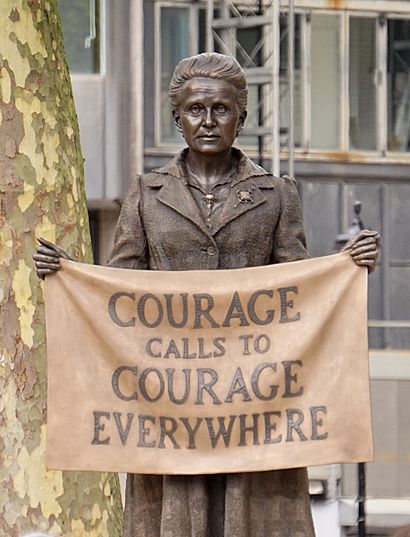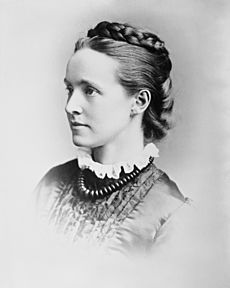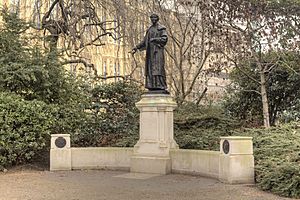Statue of Millicent Fawcett facts for kids
Quick facts for kids Millicent Fawcett |
|
|---|---|
 |
|
| Artist | Gillian Wearing |
| Year | 2018 |
| Type | Bronze |
| Location | London, SW1P 3JX United Kingdom |
| 51°30′2.98″N 0°7′38.58″W / 51.5008278°N 0.1273833°W | |
The statue of Millicent Fawcett stands in Parliament Square in London. It honors Millicent Fawcett, an important British leader who fought for women's right to vote. She was also a social campaigner. The artist Gillian Wearing created the statue in 2018.
The idea for the statue came from a campaign by activist Caroline Criado Perez. Both the Prime Minister, Theresa May, and the Mayor of London, Sadiq Khan, supported the project. This statue is the first monument in Parliament Square to honor a woman. It is also the first sculpture there made by a woman. The government's Centenary Fund paid for the statue. This fund celebrated 100 years since some women in the UK gained the right to vote. The statue was officially revealed on April 24, 2018.
Contents
What the Statue Looks Like
The bronze statue shows Dame Millicent Fawcett when she was 50 years old. This was when she became the leader of the National Union of Women's Suffrage Societies (NUWSS). The statue holds a banner that says: "COURAGE/ CALLS TO/ COURAGE/ EVERYWHERE". This quote comes from a speech Fawcett gave in 1920.
She wears a walking suit, which was a common outfit for women during the late 1800s. It includes a long coat and a dress. The artist, Gillian Wearing, made the bronze look like the texture of tweed fabric. The Fawcett Society even lent Wearing a piece of Fawcett's own jewelry. Wearing scanned this brooch and added its design to the statue.
The first design of the statue was changed a little. Some people thought the way Fawcett held the sign made it look like she was hanging laundry. So, Wearing changed the design. She moved Fawcett's hands to the corners of the sign. She also made the sign lower and flatter.
People Honored on the Statue
The names and pictures of 55 women and four men are carved into the base of the statue. These people all supported women's right to vote. Here are their names:
- Louisa Garrett Anderson
- Dame Margery Corbett Ashby
- Margaret Ashton
- Minnie Baldock
- Frances Balfour
- Lydia Becker
- Rosa May Billinghurst
- Teresa Billington-Greig
- Helen Blackburn
- Ada Nield Chew
- Frances Power Cobbe
- Jessie Craigen
- Emily Wilding Davison
- Charlotte Despard
- Flora Drummond
- Elizabeth Clarke Wolstenholme Elmy
- Isabella Ford
- Henrietta Franklin
- Mary Gawthorpe
- Eva Gore-Booth
- Anna Haslam
- Claude Hinscliff
- Laurence Housman
- Edith How-Martyn
- Elsie Inglis
- Annie Kenney
- George Lansbury
- Minnie Lansbury
- Mary Lowndes
- Mary Macarthur
- Margaret Mackworth, 2nd Viscountess Rhondda
- Chrystal Macmillan
- Catherine Marshall
- Eva McLaren
- Priscilla Bright McLaren
- Dora Montefiore
- Edith Mansell Moullin
- Catherine Osler
- Maud Palmer, Countess of Selborne
- Adela Pankhurst
- Dame Christabel Pankhurst
- Emmeline Pankhurst
- Sylvia Pankhurst
- Emmeline Pethick-Lawrence
- Frederick Pethick-Lawrence
- Agnes Pochin
- Eleanor Rathbone
- Sarah Reddish
- Annot Robinson
- Esther Roper
- Lolita Roy
- Agnes Maude Royden
- Julia Scurr
- Hanna Sheehy-Skeffington
- Sophia Duleep Singh
- Nessie Stewart-Brown
- Ray Strachey
- Helena Swanwick
- Ellen Wilkinson.
The Idea for a Woman's Statue
The idea for a statue of a woman in Parliament Square started on March 8, 2016. This day is International Women's Day. A journalist and campaigner named Caroline Criado Perez noticed that all the statues in the square were of men. She decided to start a campaign.
Criado Perez had already helped get a woman on British banknotes. Before, Elizabeth Fry was replaced by Winston Churchill on the £5 note. After Criado Perez's campaign, the Bank of England announced that Jane Austen would appear on the new £10 note.
Her new campaign asked for a statue of a suffragette in Parliament Square. This was to be ready for the 100-year anniversary of the Representation of the People Act 1918. This law gave some women the right to vote. Criado Perez found out that only a very small number of statues in the UK were of individual women. Most statues of women were of members of the royal family.
On May 10, 2016, 42 important women signed an open letter. They sent it to the new Mayor of London, Sadiq Khan. They asked for a suffragette statue in Parliament Square by February 2018. Khan quickly agreed to a new statue. He said they would find a good place for it.
An online petition for the statue received 74,000 signatures. This petition was given to Parliament on June 7. Criado Perez said she believed Millicent Fawcett should be the subject of the statue. She felt it was "shocking" that Fawcett did not already have her own statue. She also said Parliament Square was the perfect place for it.
On April 2, 2017, it was announced that a statue of Fawcett would be built in Parliament Square. Prime Minister Theresa May said that Fawcett's example still inspires people today. She said it was right to honor Fawcett in Parliament Square. The Suffrage Statue Commission chose Gillian Wearing to create the statue. The government's Centenary Fund paid for it.
Other Statue Campaigns
There was another campaign to put a statue of Emmeline Pankhurst in Parliament Square. This campaign started in 2014. Former Prime Minister David Cameron and other important people supported it. There was already a statue of Pankhurst in Victoria Tower Gardens since 1958. This park is next to the Palace of Westminster.
The Pankhurst campaign first wanted to move this existing statue to Parliament Square. But they found it was too small. So, they asked sculptor Angela Conner to make a new, larger statue of Pankhurst. There were talks about having two statues in the Square: one of Fawcett and one of Pankhurst.
However, the Fawcett campaign decided against having two statues. Caroline Criado Perez wanted a single statue for a new woman to be "front and centre." She worried that two statues might not be as noticeable. Westminster City Council decided to go with the Fawcett statue. They said a Pankhurst statue might be considered later.
The Pankhurst statue made for Parliament Square was then placed in Brompton Cemetery. This is where Emmeline Pankhurst is buried. There was also a campaign for a statue of former Prime Minister Margaret Thatcher in Parliament Square. But the Council said no. This was because of a rule that 10 years must pass after a person's death. Also, Thatcher's family did not like the design.
Statue Unveiled
The statue was officially revealed on April 24, 2018. The ceremony lasted an hour. The Prime Minister, the Mayor of London, schoolchildren, and choirs were all there. Three generations of women and girls unveiled the statue. These included Jennifer Loehnis (a descendant of Fawcett), Caroline Criado Perez, and two schoolgirls.
At the event, Prime Minister May praised Fawcett's work. She said Fawcett not only helped women get the right to vote. She also made it possible for women like herself to become Members of Parliament.
Caroline Criado Perez said the statue's unveiling was "a hell of a start." She meant it was a great beginning for more women to be represented in Britain. Mayor Khan and other political leaders agreed. Some even suggested moving the male statues in Parliament Square temporarily. This would allow only female statues to be in this important spot for a time.




